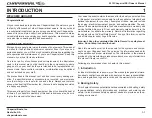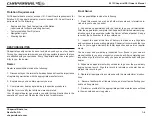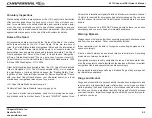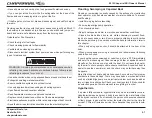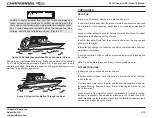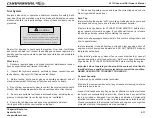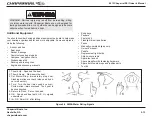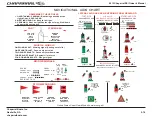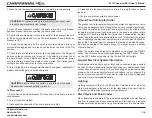
2013 Chaparral SSi Owner’s Manual
Chaparral Boats, Inc.
Nashville, GA
chaparralboats.com
2-4
SAFETY EQUIPMENT
Important: Federal law requires you to provide and maintain safety
equipment on your Chaparral boat. As the boat owner, you are re-
sponsible for supplying all required safety equipment. Consult your
Coast Guard, state, and local regulations to ensure your boat has
all required safety equipment on board. Additional equipment may
be recommended for your safety and that of your passengers. Make
yourself aware of its availability and use.
Personal Flotation Devices (PFDs)
There must be one United States Coast Guard approved wearable per-
sonal fl otation device of Type I, II, or III for each person on board or being
towed on water skis, water sports tubes, kneeboards, etc. and one Type
IV throwable device on board. The PFDs must be of a suitable size for
each person aboard and must be in serviceable condition and readily
accessible.
PFD Type I, Wearable: This off-shore life jacket has the greatest buoy-
ancy. It is most effective for all waters where rescue may be delayed. Its
design allows for turning most unconscious persons in the water from a
face down position to a vertical or face-up position.
PFD Type II, Wearable: This near-shore buoyant vest provides less
buoyancy than a Type I PFD. It is intended for calm inland water or wa-
ters where there is a chance of quick rescue. It turns its wearer to a
face-up position as does the Type I PFD, but the turning action is not as
pronounced as the Type I, and it will not turn as many persons under the
same conditions as a Type I.
PFD Type III, Wearable: Classifi ed as a fl otation aid, this PFD allows
wearers to place themselves in a vertical or face-up position in the water.
Type III has the same minimum buoyancy as a Type II PFD. It has little
or no turning ability. People participating in water sports often prefer this
PFD because it intended for use in waters where quick rescue is possible
and it is generally the most comfortable for continuous wear.
PFD Type IV, Throwable: You must also have aboard at least one throw-
able PFD Type IV device. The Type IV device can be thrown to a person
in the water and grasped and held by the user until rescued. The design
does not allow it to be worn. The most common Type IV PFDs are buoy-
ant cushions or ring buoys. This PFD must be immediately available for
use and in serviceable condition.
PFD Type V: Must be worn to be effective. When infl ated, it provides
buoyancy equivalent to Type I, II, or III PFDs.
Fire Extinguishers
As the boat owner, you are responsible for making sure you have the re-
quired number of fi re extinguishers. Fire extinguishers must be approved
by the U.S. Coast Guard.
Boats longer than 26 feet and shorter than 40 feet: Two Type B-1 or at
least one Type B-2 portable hand extinguishers. If your boat has a fi xed
fi re extinguishing system approved by the U.S. Coast Guard, one Type
B-1 extinguisher is required.
Boats longer than 16 feet and shorter than 26 feet: At least one portable
hand Type B-I fi re extinguisher.
All fi re extinguishers should be mounted in a readily accessible location
away from the engine compartment. Everyone on board should know
where the fi re extinguishers are and how to operate them.
If your fi re extinguisher has a charge indicator gauge, cold or hot weather
may affect the gauge reading. Consult the instruction manual supplied
with the fi re extinguisher to determine the accuracy of the gauge.
Visual Distress Signals
The U.S. Coast Guard requires all boats operating on U.S. coastal waters
have visual distress signal equipment on board. In general, coastal wa-
ters include all waters except rivers, streams, and inland lakes. The Great
Lakes are considered coastal waters as is a river mouth more than two
miles wide. Boats owned in the United States and operating on the high
seas must also carry visual distress signal equipment.


